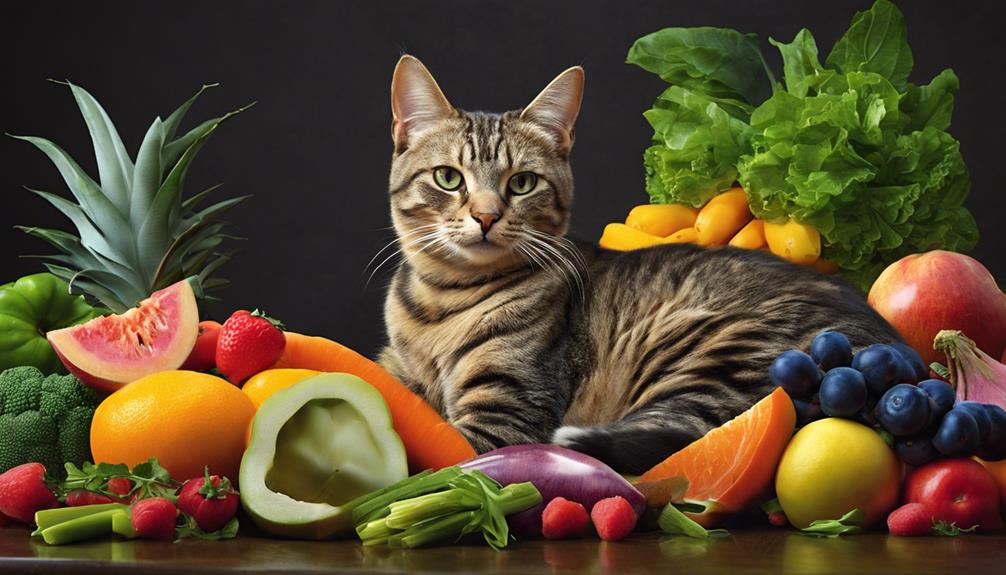Beginning a raw food diet for my cat is a solid decision for their health, honoring their natural dietary instincts. The benefits are clear: it enhances overall well-being, supplies essential nutrients like taurine in abundance, aids in digestion, and mimics what a wild feline would consume. The key to success lies in proper handling of raw meals, ensuring food safety, hygiene, and refrigeration. Formulating a well-rounded diet with various proteins, monitoring changes, and consulting with a veterinarian are crucial. Additionally, exploring new proteins, nutrients, and dental care with bones enhances their diet. This guide marks just the start of a journey toward feline wellness.
Key Takeaways
- Include a variety of protein sources for balanced nutrition.
- Incorporate organ meats to provide essential nutrients.
- Supplement with taurine and omega-3 fatty acids for health.
- Offer raw bones for dental health benefits.
- Consult a vet or nutritionist for a balanced raw diet plan.
Benefits of Raw Food Diet for Cats
Shifting your feline companion to a raw food diet can bring about a range of health benefits. Cats are obligate carnivores, meaning their bodies thrive best on a diet primarily consisting of animal products. A raw diet closely mimics what cats would eat in the wild, providing essential nutrients like taurine, an amino acid essential for feline health. This diet helps improve digestion and nutrient absorption, leading to better overall health.
One of the significant advantages of a raw food diet for cats is weight management. By eating a diet high in protein and low in carbohydrates, cats are less likely to become overweight or obese. Additionally, the natural enzymes and nutrients found in raw food can enhance skin and coat health, giving your feline friend a shiny and soft coat. Many cat owners also notice increased energy levels and vitality in their cats when they switch to a raw diet, leading to a more active and playful companion.
Proper Preparation of Raw Meals

When preparing raw meals for your feline friend, always prioritize food safety by handling raw meat with caution. Proper hygiene practices, such as washing hands and cleaning surfaces thoroughly, are essential to avoid bacterial contamination.
Food Safety Tips
Thoroughly cleaning surfaces and utensils is vital when preparing raw meals for cats to prevent cross-contamination. It's essential to use separate cutting boards for raw meat to avoid bacterial contamination in your raw cat food.
Keep the raw cat food refrigerated at all times to prevent bacterial growth and spoilage. When thawing frozen raw cat food, do so in the refrigerator to maintain food safety and prevent bacterial proliferation.
Following proper portioning guidelines guarantees your feline friend receives a balanced and safe raw food diet. By paying attention to these food safety tips, you can confidently prepare nutritious meals for your cat while keeping them healthy and happy.
Handling Raw Meat
Handling raw meat for your cat's meals requires strict adherence to food safety practices to guarantee their well-being. When dealing with raw food, especially raw chicken, it's essential to follow these steps:
- Keep it refrigerated: Prevent bacterial growth by storing raw meat at the right temperature.
- Thaw properly: Use the refrigerator or cold water to thaw raw meat safely and avoid contamination.
- Avoid cross-contamination: Use separate cutting boards and utensils for raw meat to prevent mixing with other foods.
- Wash hands thoroughly: After handling raw meat, wash your hands with soap and water to prevent foodborne illnesses.
Following these simple yet necessary steps will help ensure the safety of the raw meals you prepare for your beloved feline friend.
Balanced and Nutritious Cat Diet
To guarantee your cat maintains peak health, a balanced and nutritious diet is vital, providing the necessary nutrients for their well-being.
When it comes to feline nutrition, raw feeding can offer numerous benefits. Raw food diet recipes for cats should prioritize high-quality proteins like meat, organs, and bones, making certain they receive essential nutrients such as protein, taurine, fatty acids, and vitamins.
It's essential to balance the calcium to phosphorus ratio in raw cat diets to support bone health adequately. Including a variety of ingredients in their meals, such as different meats and vegetables, can help prevent nutrient deficiencies and ensure a well-rounded diet.
Consulting with a veterinarian or a feline nutritionist, like the Feline Nutrition Foundation, is recommended to tailor homemade raw cat food recipes to meet your cat's specific dietary needs.
New to Raw Feeding Guide

When acquainting your cat with a raw food diet, it's crucial to begin with the fundamentals. Grasping the principles of raw feeding and how to gradually introduce your feline friend is vital.
This guide will offer you practical suggestions to aid your cat in flourishing on a raw diet.
Raw Feeding Basics
Exploring the fundamentals of raw feeding for cats offers a valuable insight into providing a species-appropriate diet for our feline companions. When it comes to raw feeding, cats' health and well-being are the top priorities.
Here are some essential points to keep in mind:
- Raw feeding involves uncooked meats, organs, and bones to mimic a cat's natural diet.
- The raw food diet aims to preserve essential nutrients lost during cooking.
- Balancing the raw diet with the right proportions of proteins, fats, and nutrients is important for your cat's health.
- Proponents of raw feeding believe it can enhance a cat's coat, digestion, and overall importance.
Transitioning to Raw
How can one effectively switch their cat to a raw food diet for best health and nutrition?
Cats need a gradual change to raw food to avoid digestive issues. Start by introducing small amounts of raw meat and slowly increase the portion over time. It's important to monitor your cat's health during this process and adjust the raw food ratio as necessary.
Consider conducting feeding trials to determine what works best for your feline friend. Consulting with a veterinarian or feline nutritionist can offer valuable guidance on moving to a raw diet.
Whether opting for pre-made raw food options or preparing DIY recipes, make sure that the diet is balanced and includes essential connective tissue for best feline nutrition.
Expanding Your Cats Diet

To diversify your cat's diet, consider incorporating new proteins such as rabbit, quail, or venison. These proteins offer a variety of flavors and nutrients that can benefit your cat's overall health and enjoyment of their meals.
Here are some ways to expand your cat's diet effectively:
- Try new proteins: Experiment with rabbit, quail, or venison to provide different tastes and textures for your cat.
- Incorporate organ meats: Liver, heart, and kidney are rich in essential nutrients that can support your cat's muscle development and overall well-being.
- Include supplements: Enhance the nutritional value of your cat's diet by adding taurine, omega-3 fatty acids, and vitamin E to make certain they receive all the necessary nutrients.
- Vary bone sources: Maintain your cat's dental health and provide essential calcium by offering a mix of bone sources like chicken wings, necks, or backs.
Cat Health and Well-being

Cat health and well-being are greatly influenced by the quality and balance of their diet. Feeding your feline friend a raw food diet can have numerous benefits for their overall health. Raw diets provide essential nutrients in their natural form, promoting a healthy weight and reducing the risk of obesity-related issues.
Not only can a raw food diet improve your cat's weight, but it can also lead to shinier coats and healthier skin due to the high-quality ingredients. Additionally, raw food diets may help prevent dental problems by reducing plaque and tartar buildup. The natural enzymes present in raw food can aid in digestion and nutrient absorption, contributing to your cat's well-being.
When it comes to pet nutrition, choosing the right type of pet food is vital for maintaining your cat's health and ensuring they live a long and happy life. Follow a feeding guide that aligns with your cat's nutritional needs to support their overall health and well-being.
Homemade Cat Food Recipes

Exploring homemade cat food recipes offers a personalized approach to meeting your feline companion's unique dietary requirements and preferences. When considering homemade cat food, here are some key points to keep in mind:
- Tailored nutrition: Homemade recipes can be customized to meet your cat's specific nutritional needs.
- Quality control: By preparing food at home, you have control over the quality and sources of ingredients used.
- Allergy management: Homemade meals can help address common allergies and sensitivities that some cats may have to commercial foods.
- Customization options: Creating your own cat food allows for customization based on factors like age, health conditions, and activity levels.
Crafting homemade cat food provides an opportunity to make sure that your cat receives a diverse range of essential nutrients tailored to their individual requirements. By taking a hands-on approach to your cat's diet, you can cater to their unique preferences and nutritional needs, promoting overall health and well-being.
Nutrition and Health Tips

Considering the advantages of a raw food diet for cats, integrating nutrition and health tips can greatly enhance your feline companion's well-being. When your cat gets a balanced raw food diet, they benefit from essential nutrients like taurine, important for their health. Unlike a cooked diet, raw food recipes can help maintain your cat's ideal body weight and reduce the risk of chronic diseases such as diabetes and kidney issues. Since cats are obligate carnivores needing high-quality animal protein sources, raw food diets provide the necessary nutrition. Additionally, these diets promote dental health by aiding in tartar prevention through chewing on raw meat and bones.
| Nutrition Tips | Health Tips | Benefits |
|---|---|---|
| Balanced Diet | Disease Prevention | Essential Nutrients |
| Animal Protein | Dental Health | Ideal Body Weight |
| Taurine | Tartar Prevention | Reduced Health Risks |
| High-Quality Sources | Raw Bones | Improved Well-being |
| Raw Meat | Dental Health Promotion |
Feeding Guidelines for Cats

To guarantee top health and nutrition for your kitty friend, adhering to accurate feeding guidelines is essential. When it comes to feeding your cat, here are some key points to keep in mind:
- Cats eat like obligate carnivores: Their diet should consist mainly of essential animal-based proteins like meat, organs, and bones.
- Feed a balanced raw diet: Aim for 80% muscle meat, 10% organs, and 10% bone to mimic their natural prey.
- Consult a veterinary nutritionist: Get expert advice on vital nutrients like taurine, omega-3 fatty acids, and vitamins essential for your cat's health.
- Rotate protein sources: Add variety to prevent nutrient deficiencies and keep mealtime exciting for your feline friend.
Frequently Asked Questions
What Should I Feed My Cat on a Raw Diet?
I feed my cat a balanced raw diet consisting of muscle meat, organs, bones, and various protein sources like chicken, turkey, beef, and fish. Supplements like taurine, omega-3 fatty acids, and vitamins are essential for her health.
Why Don T Vets Recommend a Raw Diet for Cats?
I don't recommend raw diets for cats due to bacterial risks like Salmonella and nutritional imbalances that can harm feline health. Commercial cat food meeting AAFCO standards provides balanced nutrition backed by science, supporting long-term cat well-being.
What Proportions Should a Cat's Raw Diet Be?
In a cat's raw diet, the proportions should ideally be around 80% muscle meat, 10% edible bone, 5% liver, and 5% other secreting organs. These ratios provide essential nutrients like protein, calcium, and vitamins needed for peak feline health.
How Do You Make Raw Food for Cats?
I make raw food for cats by sourcing quality ingredients like muscle meat, organs, and bone. I add essential supplements for a balanced diet. Ensuring cleanliness and gradual change is crucial for success.
What Are Some Recipes for Raw Food Diet for Cats That Incorporate Darwin Raw Cat Food?
When it comes to feeding your cat a raw food diet, incorporating Darwin raw cat food uniqueness is key. Some recipes to consider include a simple mix of raw meat, organs, and bones, along with supplements for a balanced diet. Another option is a raw food blend with Darwin raw cat food uniqueness for added nutrition.
Conclusion
To sum up, raw food diet recipes for cats offer a multitude of benefits, including enhanced health and well-being. By properly preparing balanced and nutritious meals, cat owners can guarantee their feline companions receive the essential nutrients they need to thrive.
Whether you're new to raw feeding or looking to expand your cat's diet, homemade recipes and feeding guidelines can help promote a healthy lifestyle for your beloved pet. Give raw feeding a try and see the positive impact on your cat's health!










